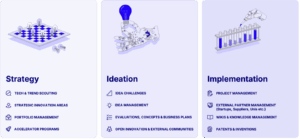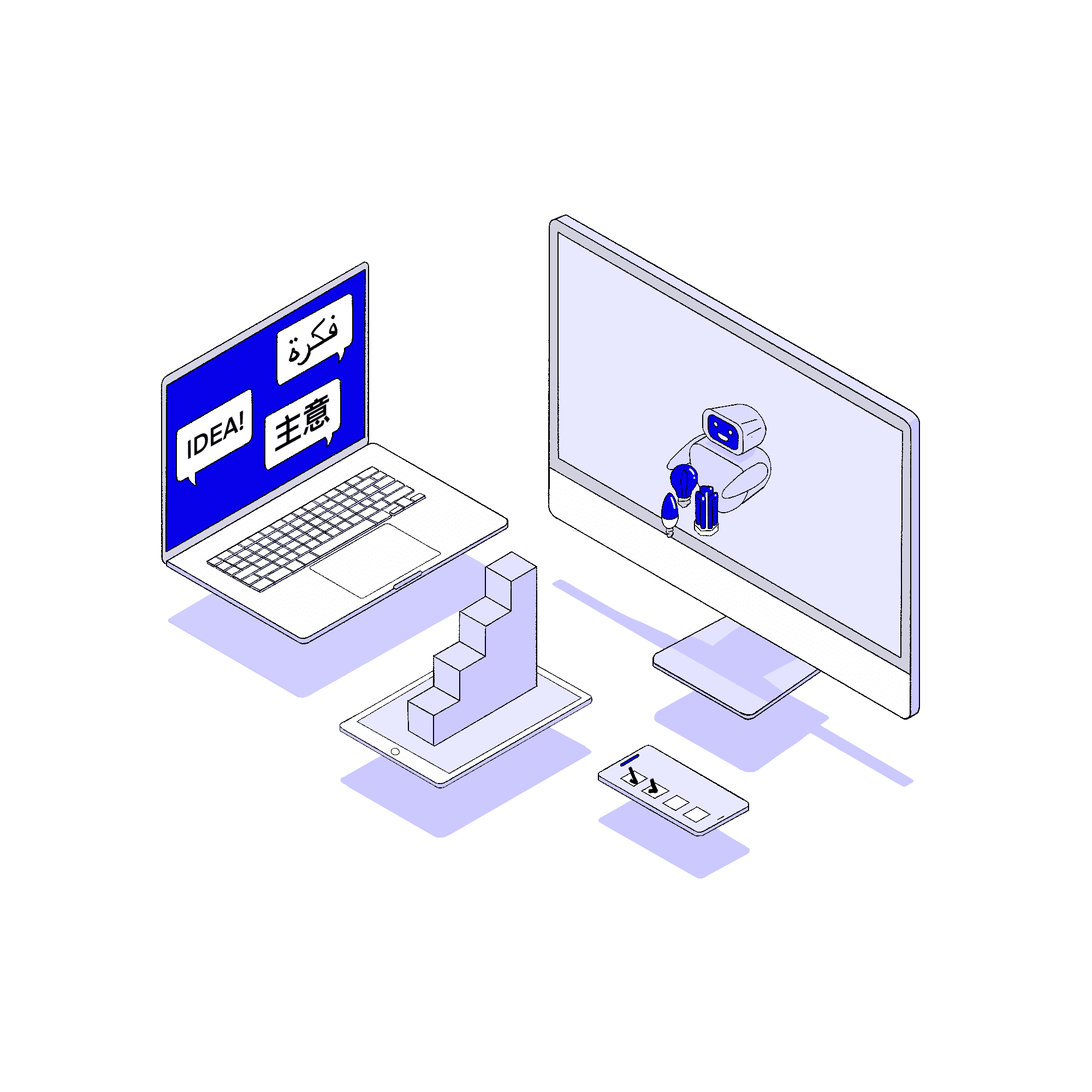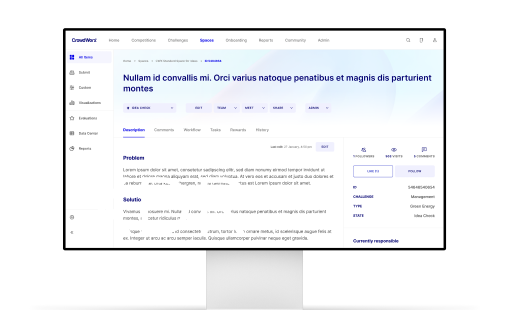Do you know which tool actually drives meaningful business transformation? Idea management software primarily focuses on collecting and evaluating suggestions, whereas innovation management systems offer comprehensive end-to-end capabilities for implementing and scaling innovations. Indeed, choosing the wrong platform can significantly impact your innovation initiatives, leading to wasted resources and missed opportunities. Additionally, the idea management platform you select should complement your existing workflows, while a robust innovation management system must align with broader strategic goals.
This guide breaks down the key differences, essential features, and selection criteria to help you determine whether you need an innovation management solution, an idea management tool, or perhaps both working together. We examined the top seven innovation management and idea management software platforms available in 2025, analyzing their strengths, weaknesses, and ideal use cases to help you make an informed decision.
What is Idea vs Innovation Management Software
Idea management software provides a structured way to capture, organize, and evaluate ideas from employees, customers, and stakeholders. It acts as a central hub for submitting, voting on, and refining suggestions. Most platforms include submission portals, voting systems, and evaluation tools with customizable, multilingual interfaces. They centralize feedback, encourage participation, make evaluation transparent, and track ideas from submission to implementation.
Innovation management software covers the full innovation lifecycle — from strategy and resource allocation to execution and market delivery and typically include capabilities for:
- Strategic alignment of innovation initiatives
- Portfolio management and resource allocation
- Workflow automation with stage-gate processes
- Cross-functional collaboration tools
- Analytics and ROI tracking
Evaluation Criteria for Selecting the Right Platform
Choosing the ideal innovation or idea management platform requires a systematic evaluation across multiple dimensions. The following criteria will help you select a solution that truly meets your organization’s needs.
Strategic Fit
Evaluating strategic alignment should be your first consideration when selecting any innovation platform. The solution must enable your organization to make innovation repeatable at scale and handle diverse inputs and ideas. Prior to reviewing software options, clearly define your innovation goals to ensure the platform aligns with your broader business objectives. Remember that the strategic fit between innovation strategies and performance is fundamental for long-term success.
Functional Capabilities
Look beyond basic features and assess how well the platform supports critical functions. Robust solutions should offer core features like:
Idea Collection and Feedback Systems
- Structured submission processes with customizable forms
- Multi-audience feedback collection (employees, customers, partners)
- Quality-focused voting mechanisms with reasoning requirements
Workflow Automation and Evaluation
- Flexible workflows adapted to different innovation types
- Configurable assessment stages with specific criteria
- Automated task routing and progress notifications
Collaboration and Engagement Features
- Employee engagement tools and recognition systems
- Organization-wide transparency and participation
- Seamless integration with existing communication platforms
Portfolio Management Capabilities
- Customizable reporting system
- Data center with multiple data attributes, filtering, sorting and exporting options
- Customizable portfolio analysis
The key is matching platform capabilities to your organization’s specific innovation goals and processes. While platforms like Crowdworx offer comprehensive functionality across all these areas, smaller organizations might not require the full feature set.
Ease of Use and Onboarding Speed
Although innovation impact ultimately matters most, user adoption remains critical for platform success. Prioritize solutions that offer intuitive interfaces allowing teams to become productive with minimal training. As noted by experts, software implementation proves more effective when systems are easy to use and demonstrate immediate time savings.
Workflow Customization and Flexibility
Every organization has unique innovation processes. Hence, select platforms that support multiple customized workflows rather than forcing a single approach. Ideal systems allow you to duplicate, edit, and configure workflows that match your specific needs. At the very least, ensure you can create distinct pathways for different innovation types.
Crowdworx is the most customizable software on the market offering the biggest amount of modules for Idea Management and Innovation Management and also for adjacent areas.
Integrations & Ecosystem
The value of idea and innovation management software increases significantly when it connects with your existing technology stack. Given this requirement, evaluate platforms that integrate smoothly with collaboration tools, customer relationship management systems, and business intelligence applications. These connections enable rich analytics capabilities and informed decision-making.
Security, Privacy & Compliance
With innovation data often representing competitive advantages, security cannot be overlooked. Evaluate vendors offering robust protections like GDPR compliance. Correspondingly, check if platforms provide data residency options, letting you control where information is stored to meet regional regulations.
Innovation and Idea Management Software Comparison
Crowdworx: The Most Comprehensive Innovation Platform
Crowdworx stands out as the most comprehensive platform in terms of module count compared to other market solutions. While other platforms offer typical modules like trend scouting, project management, and idea challenges, Crowdworx’s module portfolio is significantly larger. The platform remains flexible by allowing clients to select only the modules they need, enabling companies to run a fully integrated platform not just for Idea Management and Innovation Management, but also for adjacent areas.
Key Strengths:
- Most comprehensive feature set for an All-in-One platform for Idea and Innovation Management
- Most customizable platform on the market
- Advanced AI features for enhanced idea evaluation and processing
- Very wide range of idea evaluation methods
- Advanced automation capabilities
- Unique multi-lingual translation capabilities for ideas, workflow actions, and search—providing the smoothest cross-country collaboration experience on the market
Potential Limitations:
- Initial configuration for advanced use cases can be time-consuming, though this is mitigated when performed by Crowdworx professionals
- The wide range of capabilities might be less suitable for smaller companies
- Reliance on third-party databases for startup scouting, signals, and trends—some are fully integrated and searchable via the platform, others are not
Module Suite:
Crowdworx’s growing suite includes: Innovation Management, Idea Management, Idea Challenges, Open Innovation, Tech & Trend Scouting, Partner Management (for Startups, Suppliers, Universities, etc.), Project Management, Internal Improvements, Kaizen Workshops, Innovation Wikis, Best Practice Know-How (e.g., Innovation Learnings), Portfolio Management, Inventions & Patents Management, Tracking of Measures for OPEX & Change Programs, New Concept Testing, Survey Module, Hackathon Module, and Corporate Accelerator Module.
The platform offers near-unlimited extension capability through Crowdworx Custom Modules™, allowing clients to build custom modules for any use case. Hosting multiple processes on one platform has proven beneficial, with many Crowdworx customers highlighting reduced IT costs (due to fewer IT tools to pay for and operate) and increased user satisfaction (users finding everything in one place, with global search and excellent linking capabilities).

Innovationcast: Simplicity-Focused Solution
Innovationcast presents itself as a “refreshingly simple, yet uniquely effective Innovation Management platform.” The focus is not on breadth or advanced features, but rather on a streamlined set of features and basic innovation tools.
Strengths:
- Very simple and easy-to-use platform
Weaknesses:
- Very limited functionality—sometimes even basic features such as Startup Scouting, Projects, and Portfolio Management are missing
- Very limited reporting functionality (no Portfolio Charts, Financial Charts, Topic Clustering, or Organizational Analytics)
- Currently no AI capabilities
Module Suite:
Innovationcast offers a simple set of modules for classic innovation disciplines:
- Scouting for signals (but no database for trends, startups, or technologies)
- Idea challenges
- Testing & validation of hypotheses
- Simple project management
- Basic innovation reporting
Beyond these areas, capabilities are limited, making it suitable for organizations with basic innovation needs that prioritize simplicity over comprehensive features.
Wazoku: External Collaboration Specialist
Wazoku’s offering focuses not only on an innovation platform but also includes a substantial services component. It operates multiple different products: one for Idea Challenges, one for scouting market intelligence (startups, trends, etc.), and one for managing its own community of creatives and solvers (acquired from another company).
Strengths:
- Primary USP is access to market intelligence, including their own community for crowdsourcing projects
- Large consulting offering
- Easy-to-use platform
- Strong AI capabilities
Weaknesses:
- Limited or no Innovation Management capabilities for radars, project management, and continuous improvements
- Limited cross-country capabilities (currencies, multi-lingual collaboration, multi-lingual search)
- Limited customization capabilities
Areas of Specialization:
Wazoku has three specialization areas:
- Market Intelligence: Trend & technology scouting, startup scouting, universities, competitor innovation activities, and more
- Innovation Management: Classic idea challenges, idea management, idea evaluation
- Ecosystem Management: Open Innovation and a community of 500,000 creatives and solvers for crowdsourcing ideas and solutions
These specializations are spread among different software tools that Wazoku has acquired over time, so not everything is integrated into a single platform—at least not currently.
Brightidea: Idea Challenge Platform
Brightidea’s platform focuses solely on Idea Challenges. It uses Idea Challenges for various use cases, which it calls “Apps”—including classic ideation, Venture Scouting campaigns, Cost Savings campaigns, Trend Monitoring campaigns, Startup Scouting campaigns, and more. However, all these “Apps” are simply Idea Campaigns configured with different process steps, roles, and evaluation criteria.
Strengths:
- Very strong Idea Challenge capabilities
- Good automation rules
- Wide range of idea evaluation tools
Weaknesses:
- Applying Idea Challenges to other Innovation Management activities (Cost Savings programs, Trend Monitoring, Startup Scouting) doesn’t produce optimal results for users
- No support for Project Management, Portfolio Management, Radar Charts, Tech Scouting, Partner Management, or Continuous Improvements
- Limited AI capabilities, mostly around idea submission and recommendation
Brightidea attempts to be an All-in-One platform by using its Idea Challenges functionality for many different use cases called “Apps.” However, this doesn’t provide the solid, deep capabilities of a proper All-in-One Innovation Platform.
Additionally, Brightidea offers two other products: a whiteboarding tool similar to Miro, and a memo tool for creating long-form memos.
IdeaScale: Community-Focused Platform
IdeaScale’s platform focuses on Idea Challenges and Communities. It provides necessary tools for collecting and evaluating ideas, plus cost & value estimation tools. IdeaScale’s major focus is catering to different communities within a company, each having their own workspace for running Idea Challenges.
Strengths:
- Ease of use with clear simple and intermediate features
- Clear focus on Idea Challenges and Community Management
- Community areas, each with own homepage, campaigns, and workflows
Weaknesses:
- No advanced innovation features (trend & tech scouting, radars, project management, partner management, portfolio management)
- Hard-coded AI features with little room for building AI applications on the platform
- Limited customization capabilities
- Very limited idea evaluation tools
Currently, IdeaScale is not an All-in-One Platform, though it has future plans to add modules beyond Idea Challenges. Their roadmap includes Project & Portfolio Management and Startup & Technology Scouting.
Additionally, IdeaScale offers another product: a whiteboarding tool similar to Miro, which can integrate with their Idea Challenges base product.
HYPE Innovation: Established Innovation Platform
HYPE is one of the oldest innovation platforms on the market with a well-established global customer base. It offers a wide range of capabilities across different platforms for internal improvements, small companies, and innovation management, including idea management and idea challenges.
Strengths:
- Comprehensive feature set for an All-in-One platform
- Very customizable platform
Weaknesses:
- Parts of the platform can appear outdated due to system age
- Configuration is complex—certified third-party consultants are available to help with initial setup
- Separate platforms (such as HYPE Boards or HYPE Improve) are sometimes not well integrated and require separate accounting as standalone products rather than an all-in-one platform
HYPE provides a broad module suite suitable for an all-in-one platform, with key modules including Innovation Management, Idea Management, Idea Challenges, and more.
Itonics: Foresight-Focused Platform
Itonics focuses on three Innovation Management areas: Foresight, Ideation, and Portfolio Management. It features crowdsourcing capabilities used by individual Innovation Managers or Foresight Managers for researching trends, signals, technologies, or startups, and for managing innovation initiative portfolios.
Strengths:
- Strong feature set for individual power users, such as Innovation Managers
- Proprietary databases for trends and signals
- Good radar charts and visualization tools
Weaknesses:
- Very high cost—Itonics is probably the most expensive system on the market. Even for a single user, the cost approaches a five-digit figure annually. For 100 users, costs reach the six-digit range.
Itonics offers All-in-One capability for individual power users by covering the Innovation Process from Market Intelligence to Ideation to Portfolio Management. Some gaps remain, however, including proper Partner Management modules, Project Management capabilities, and Internal Improvements coverage.
Conclusion: Choosing Your Innovation & Idea Management Platform
The innovation management software landscape in 2025 presents organizations with distinct choices, each serving different strategic needs and organizational maturity levels. While some platforms focus on simplicity or specific niches, others offer comprehensive ecosystems designed to handle complex, multi-faceted innovation initiatives.
However, for organizations seeking a truly comprehensive innovation and idea management solution, Crowdworx emerges as the standout choice. Its extensive module portfolio—ranging from traditional idea management to advanced capabilities like AI-powered evaluation, multi-lingual collaboration, and custom module development—positions it uniquely in the market. The platform’s ability to serve as a single, integrated hub for innovation, idea management, and adjacent business processes addresses a critical pain point: the complexity and cost of managing multiple disparate systems.

